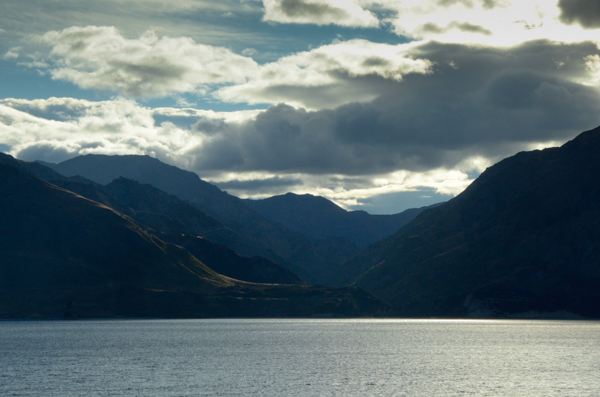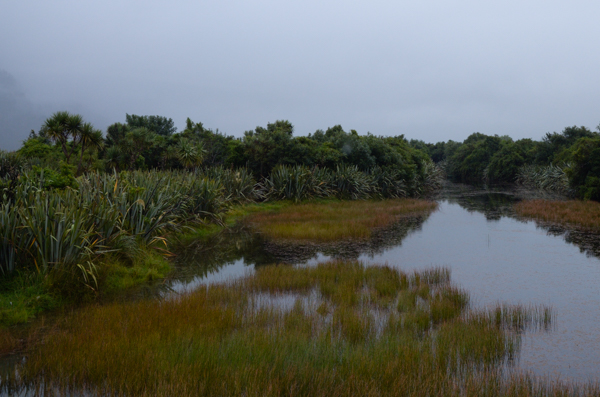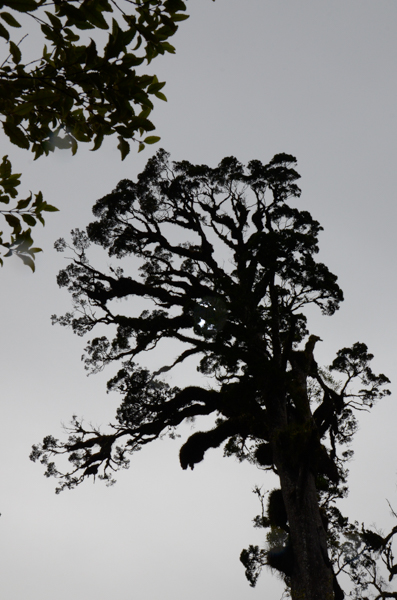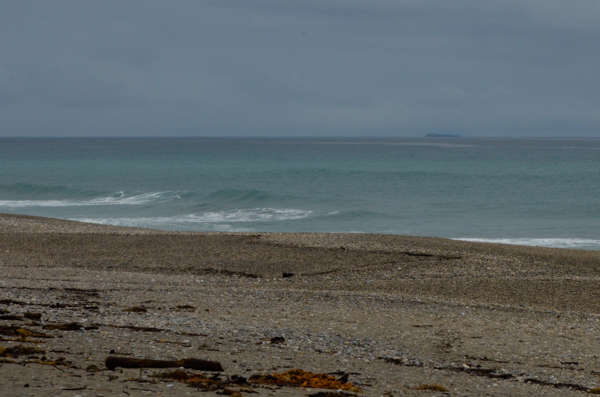After loading up in the morning we crossed the Southern Alps via the Haast Pass to Westland. We then followed the coast north with occasional interruptions as we detoured around glacial moraines.

Because of the protected status of Lake Wanaka, the highway travels up Lake Hawea, which parallels Wanaka for a number of miles then crosses west to continue to the Haast Pass.
This view is looking east across Hawea.

The Makarora River feeds Lake Wanaka from the southern side of Haast Pass.
Charles Cameron, a gold prospector, is believed to be the first European to find the pass. He crossed in January 1863, burying his powder flask to the west of the pass. Not long after, Julius von Haast named the pass after himself and claimed to be the first European to have travelled through it. The subsequent discovery of Cameron's flask discredited his claim, but the name remains.

As we traveled over the Pass, Chas told us the story of the road connecting Wanaka and the West Coast. It was completed in the 1960s. As a teenager he had helped out during holidays on the road construction. The road wasn't fully paved until the 1990s!
On the northern/western side of the pass we stopped to view Thunder Creek Falls, also known as the Ninety Foot Falls. It was a great opportunity to get off the bus, stretch our legs, and get our bearings after the twisty mountain roads.
Jim & I usually sit towards the middle of the bus, but on these curvy roads I got up early for a front seat!

As we neared the coast, we stopped at the Haast Visitors' Centre to view exhibits on early exploration and settlement.
It was surrounded by wetland.

A very odd sight at the Visitors' Centre was this juvenile gull who had run afoul of some kind of paint or dye. At first we thought it was blood, but the bird didn't seem harmed in any way -- just discolored.
Nevertheless it was an unnerving sight.

Near Ship Creek we visited a protected area of podocarp forest.
The Department of Conservation built a boardwalk to allow access to the interior. Fittingly for a swampy area on the western side of the mountains, it was raining. That did not dampen our enthusiasm for seeing this wonderful forest preserve.
The kahikatea is New Zealand's tallest tree with a lineage that dates back to the Jurassic era. These trees produce massive amounts of fruit and support numerous birds.

A number of trees in the forest had died and fallen. Chas said that the insect damage seen here would have occurred after the death of the tree. It did not kill it.
The tree was brought down in a controlled fashion to minimize damage to the preserve's infrastructure.

The tree has already begun to deteriorate and return the nutrients to the forest.
Although there were plenty of birds singing in the woods, I didn't get any pictures of any. One that we watched for a while was a New Zealand Tomtit.

This "clearing" in the swampy preserve allows enough light for a great variety of undergrowth.
The forest looks Jurassic, doesn't it?

The kahikatea was widely harvested to construct containers like these. The wood was not useful for construction, but it had a unique characteristic: no resin and no odor. It was ideal as shipping containers for butter and cheese that New Zealand exported to the rest of the world. The goods would not pick up any off-flavors from the wood even during the long ship journeys.
Once the product was unpacked at its destination the wood was discarded.

Thin translucent ferns are found throughout rain forests such as this. Called filmy ferns, sometimes they are only one cell thick.

Kidney Fern is so called because of its shape. The raindrops on the far side of the fern can be clearly seen.

Another kind of delicate fern.

A variety of epiphytes, including orchids, grow in the trees. The orchid is probably Raupeka.

At the end of our forest path it was only a short walk to the Tasman Sea.
Chas may look as if he is pensively gazing into the sea, but he is really searching to see if there are dolphins to point out to us.
There were some far offshore, but I never could get a picture of them.
 The
island seen far away at the right of the picture has an interesting
story. Four sealers were left there by a ship, which planned to return
for them a few months later. The sealers were to kill as many fur seals
as they could and preserve the skins.
The
island seen far away at the right of the picture has an interesting
story. Four sealers were left there by a ship, which planned to return
for them a few months later. The sealers were to kill as many fur seals
as they could and preserve the skins.Unfortunately the ship sank with all hands. It took four years before the sealers were found -- quite by accident. The majority of the preserved skins survived as well as the men.
At one point they managed to build a boat and come to the mainland, but there was less there for them than on their island, so they returned.Click your "back" button to return.